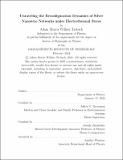Unraveling the Reconfiguration Dynamics of Silver Nanowire Networks under Electrothermal Stress
Author(s)
Trebach, Adam Morris Willner
DownloadThesis PDF (20.03Mb)
Advisor
Grossman, Jeffrey C.
Checkelsky, Joseph
Terms of use
Metadata
Show full item recordAbstract
Transparent conducting electrodes (TCEs) are vital to many optoelectronic devices including solar panels and touch-screens. Indium Tin Oxide, the dominant TCE, comes with myriad problems including a shaky supply chain and brittleness. Networks of silver nanowires show many advantages over ITO, but they suffer from problems with durability. In this work, we focus on electrothermal instability and provide new insights into the electrothermal drivers of silver nanowire network failure. First, we borrow the notion of betweenness centrality from graph theory and test its applicability to simulated nanowire network systems. We also test several other centrality measures, some introduced here and designed specifically to describe nanowire networks. We find that betweenness centrality performs as well as or better than the other tested measures in terms of ability to identify network elements least important to conduction. We then execute a combined computational and experimental analysis of several small, computationally tractable silver nanowire networks. We create high fidelity computational models of these specific systems and calculate electrical and graph theoretic properties to test whether we can predict failure. We find that standard circuit analysis outperforms graph theoretic measures, although neither prove predictive. We find strong evidence that electromigration is the primary driver of failure at contacts between silver nanowires, either by causing failure directly or by providing the kinetic perturbations required to initiate spheroidization. In the process of building our computational models of real nanowire networks, we develop several new image processing techniques that show great promise when applied to the challenging task of automatically extracting non-planar graphs from images.
Date issued
2024-02Department
Massachusetts Institute of Technology. Department of PhysicsPublisher
Massachusetts Institute of Technology